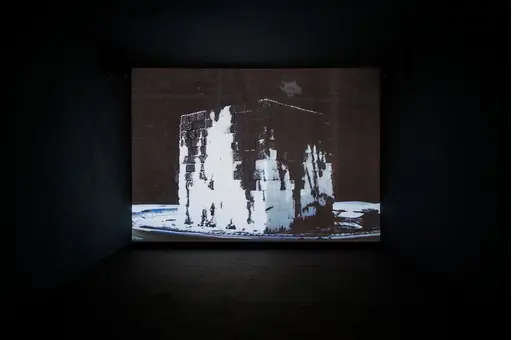
15 July 2021
Work by Kader Attia at De Voorkamer
From 15 July until 15 August 2021 the work Oil and Sugar #2 (2007) by Kader Attia is on view at De Voorkamer, as part of Fragments of Repair/Kader Attia!
De Voorkamer was founded in 2016 as an inclusive meeting space in Utrecht for status holders, people living in asylum seekers’ centers, and the local community to showcase and develop their talents. The video work is presented in the window of De Voorkamer, Kanaalstraat 225 in Utrecht (visible from outside), from Monday–Sunday, 08.00–22.00 hrs.
Artwork description
Kader Attia, Oil and Sugar #2, 2007, video, 4:30 min.
In Oil and Sugar #2, a construction made from sugar cubes dissolves as crude oil is poured onto it. It looks like a building imploding in slow motion and then returning from collapse to its initial state, time and again, as the video loops. The work speaks to the place of oil and sugar in the colonial “architecture” of the global world, historically and at present. Recalling at once the plantation and sugar slavery and petroleum and extractive capital’s machinery, the video echoes this world of inequality, injustice, poverty, repression, and exclusion for many; this is what hides behind the facade of perfectly straight lines and the clean aesthetic of western-modern minimalism that the white block alludes to. Although turning dark and melting into chaos in the process, the construction manages to endlessly return unchanged. The seeming impossibility to disrupt this vicious circle of disintegration and continuous reemergence unveils the monstrosity of the challenge ahead for the hard labor of decolonization. Yet in every decline, uncertainty, and catastrophe there is emergence and thus a possibility to reroute the loop into repair, not as a return to what has been but as a gateway between one world and the next.
In Oil and Sugar #2, a construction made from sugar cubes dissolves as crude oil is poured onto it. It looks like a building imploding in slow motion and then returning from collapse to its initial state, time and again, as the video loops. The work speaks to the place of oil and sugar in the colonial “architecture” of the global world, historically and at present. Recalling at once the plantation and sugar slavery and petroleum and extractive capital’s machinery, the video echoes this world of inequality, injustice, poverty, repression, and exclusion for many; this is what hides behind the facade of perfectly straight lines and the clean aesthetic of western-modern minimalism that the white block alludes to. Although turning dark and melting into chaos in the process, the construction manages to endlessly return unchanged. The seeming impossibility to disrupt this vicious circle of disintegration and continuous reemergence unveils the monstrosity of the challenge ahead for the hard labor of decolonization. Yet in every decline, uncertainty, and catastrophe there is emergence and thus a possibility to reroute the loop into repair, not as a return to what has been but as a gateway between one world and the next.